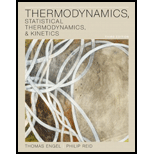
(a)
Interpretation: The final temperature for the adiabatic expansion of 0.5 mol of an ideal gas with
Concept Introduction: For an adiabatic process, the heat involved is equal to zero. The molar heat capacity at constant volume is represented as
(b)
Interpretation: The final temperature needs to be determined, if the same gas undergoes adiabatic expansion with external and final pressure equals to 1.25 bar.
Concept Introduction: The change in internal energy is calculated as follows:
Here, n is number of moles,
The work done is represented as follows:
Here, P is external pressure and
The enthalpy of a reaction is represented as follows:
Here, n is number of moles, R is Universal gas constant and
Want to see the full answer?
Check out a sample textbook solution
Chapter 2 Solutions
Thermodynamics, Statistical Thermodynamics, & Kinetics
- A sample of an ideal diatomic gas is compressed adiabatically and reversibly to double its initial pressure. By what percentage does its absolute temperature change in a the low-temperature limit and b the high-temperature limit?arrow_forwardWhat are the numerical values of the heat capacities c-v and c-p of a monatomic ideal gas,in units of cal/mol.K and L.atm/mol.K?arrow_forwardProve that the adiabatic free expansion of an ideal gas is spontaneous.arrow_forward
- The equation of state for a certain gas is given by P[(V/n)-b] = RT. Obtain an expression for the maximum work done by the gas in a reversible isothermal expansion from V1 to V2.arrow_forwardPhysical chemistry - please refer to pics Now, consider 2.0 moles of methane (CH4 ), initially at 273 K, that is reversibly and adiabatically compressed from an initial volume of 10.00 L to a final volume of 2.00 L. 3a. Determine the final temperature, considering the gas to be described by the ideal gas equation of state. 3b. Determine the work required w, the associated heat flow q, and the internal energy change ∆U for the gas between the initial and final states.arrow_forward(b) An ideal gas of 2.5 moles undergoes an adiabatic expansion at an initial pressure of 4.25 bar and at an initial temperature of 540 K to a final temperature of 400 K. Calculate the work done which is equal to internal energy change under such conditions. Assume Cp,m = 5/2 Rarrow_forward
- An ideal gas of 2.5 moles undergoes an adiabatic expansion at an initial pressure of 4.25 bar and at an initial temperature of 540 K to a final temperature of 400 K. Calculate the work done which is equal to internal energy change under such conditions. Assume Cp,m = 5/2 Rarrow_forwardSuppose that attractions are the dominant interactions between gas molecules, and the equation of state is p = nRT/V − n2a/V2. Derive an expression for the work of reversible, isothermal expansion of such a gas. Compared with a perfect gas, is more or less work done on the surroundings when it expands?arrow_forwardWhat would be the final volume occupied by 1.0 mol of an ideal gas initially at 0°C and 1.0 bar if Q = 1000J during a reversible isothermal expansion?arrow_forward
- One mole of a perfect monatomic gas, initially at 300 K and a pressure 15.0 atm, expands to afinal pressure of 1.00 atm. Consider the expansion via each of the following paths: (a)isothermal and reversible, (b) isothermal and irreversible, (c) adiabatic and reversible, (d)adiabatic and irreversible. In these irreversible processes, the expansion occurs against anexternal pressure of 1.00 atm. For each case, calculate the values of q, w, ΔU and ΔH.arrow_forwardCalculate the final temperature of a sample of argon of mass 12.0 g at 273.15 K that is expanded reversibly and adiabatically from 1.0 dm3 to 3.0 dm3. The isochoric heat capacity for argon is 12.48 J/K.mol.].arrow_forwardOne mole of a monatomic ideal gas begins in a state withP 5 1.00 atm and T 5 300 K. It is expanded reversiblyand adiabatically until the volume has doubled; then it isexpanded irreversibly and isothermally into a vacuumuntil the volume has doubled again; and then it is heatedreversibly at constant volume to 400 K. Finally, it is compressed reversibly and isothermally until a inal state withP 5 1.00 atm and T 5 400 K is reached. Calculate DSsysfor this process. (Hint: There are two ways to solve thisproblem—an easy way and a hard way.)arrow_forward
 Physical ChemistryChemistryISBN:9781133958437Author:Ball, David W. (david Warren), BAER, TomasPublisher:Wadsworth Cengage Learning,
Physical ChemistryChemistryISBN:9781133958437Author:Ball, David W. (david Warren), BAER, TomasPublisher:Wadsworth Cengage Learning,
